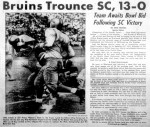There was a football game yesterday. It involved a team you probably care about. It did not go well.
But why?
No, I’m not asking why the Bruins lost again. The answer to that question can be found in many other places. This is about taking a step back from the taken-for-granted nature of College GameDays, and asking the question of why athletics matter so much on American college campuses, so much so to the point where they have long been commodified as a multi-billion dollar industry and questioning a renown athletics program is comparable to committing high treason.
The long love affair between sport and university began where most of our ideals about higher education come from: the Ivy League. That term itself – “Ivy League” – has long been synonymous with the social elite in general, not just within higher education. But we do frequently forget that it is also an athletic conference, organized during the formation of Division I NCAA in 1954. The schools, of course, predate both that behemoth of a nonprofit and the Ivy terminology itself; collegiate sports were thriving too, decades before the fact.
In “A History of American Higher Education,” college historian John R. Thelin details how intercollegiate sport developed part and parcel with a broader idea of a cohesive and heavily romanticized notion of collegiate life that came to dominate popular culture in the early-to-mid 20th century. Many of them, like lavish homecoming festivities, drunken fraternity parties and “college prep” fashion, are still very familiar to us today, though more often as trope rather than reality.
For the general public – not just the white upper middle class that would even bother with thinking about pursuing postsecondary studies during this time – there was simply something fascinating about young minds convening in neo-Gothic buildings and tree-lined quads, inventing bizarre traditions and cheering for mascots both conventional and strange.
[Related: Does UCLA even have a Quad?]
Crucially, Thelin notes that during this first era of college life’s entrance into pop-cultural popularity, actually caring about academics was frowned upon. To be a college student, being too cool for school was essentially a requirement.
What does this have to do with sports? Well, for starters, sports has not an iota to do with academics, so it passes the too-cool-for-school test. Athletics are also extremely visible and inherently interesting aspects of student life that engender loyalty; sharing the experience of a big win or heartbreaking loss with classmates strengthens one’s connection to a campus in a way no college syllabus ever could. Administrators also realized early on how massively profitable promoting athletics, particularly football, could be. In a sense, then, sports entrenched itself into American college life because the revenue-generation potential was too great to resist. The earliest great college rivalries, of course, were played out between Ivy League schools – The Race, anyone? – which were the first to enjoy a dominance in collegiate athletics.
Simply put, college sports, especially in today’s thoroughly commercialized environment with its eye-popping apparel and television deals, have never had much to do with college at all. While student-athletes are probably grateful for the education, there is very little learning involved for the admittedly select few who are preordained for success in professional sport. They are more athlete than student.
[Related: UCLA Athletics set to leave Adidas, join Under Armour in 2017]
This hardly bold notion that sport is staggeringly irrelevant to higher education is nothing new, of course. It was articulated decades ago in a legendary essay penned in 1954 – incidentally the same year the Bruins won the only football title in its history up until that point.
Writing for Sports Illustrated, University of Chicago’s president emeritus, Robert M. Hutchins, explained why the school’s then (and still) defunct football program should not be reinstated. As far he was concerned, college football was an “infernal nuisance” that contradicted historical and contemporary aims of the university, which are frequently denoted today by higher education professionals and administrators as the trio of teaching, research and service.
What is remarkable is how valid Hutchins’s analysis remains today. He notes that the recruitment of athletes for football (and other major, revenue-garnering sports, for that matter) generally involves the bending of rules and special treatment — which ought to call into question the “amateurism” ideal that the NCAA unendingly and incessantly uses to defend itself against critics who call for monetary compensation of players. He details the role sport plays as a way to capture the much-needed dollars of alumni who apparently can’t find any other way to care about their alma mater; which, needless to say, is a need that has only intensified in recent decades.
So, will I be watching the Bruins during their next, and hopefully less hapless, appearance at the Rose Bowl? Yes, probably. But when the next email begging me to donate to the school arrives, any decision to write that check is going to be based on whether or not it can further the university’s academic endeavors, not its winning records.
